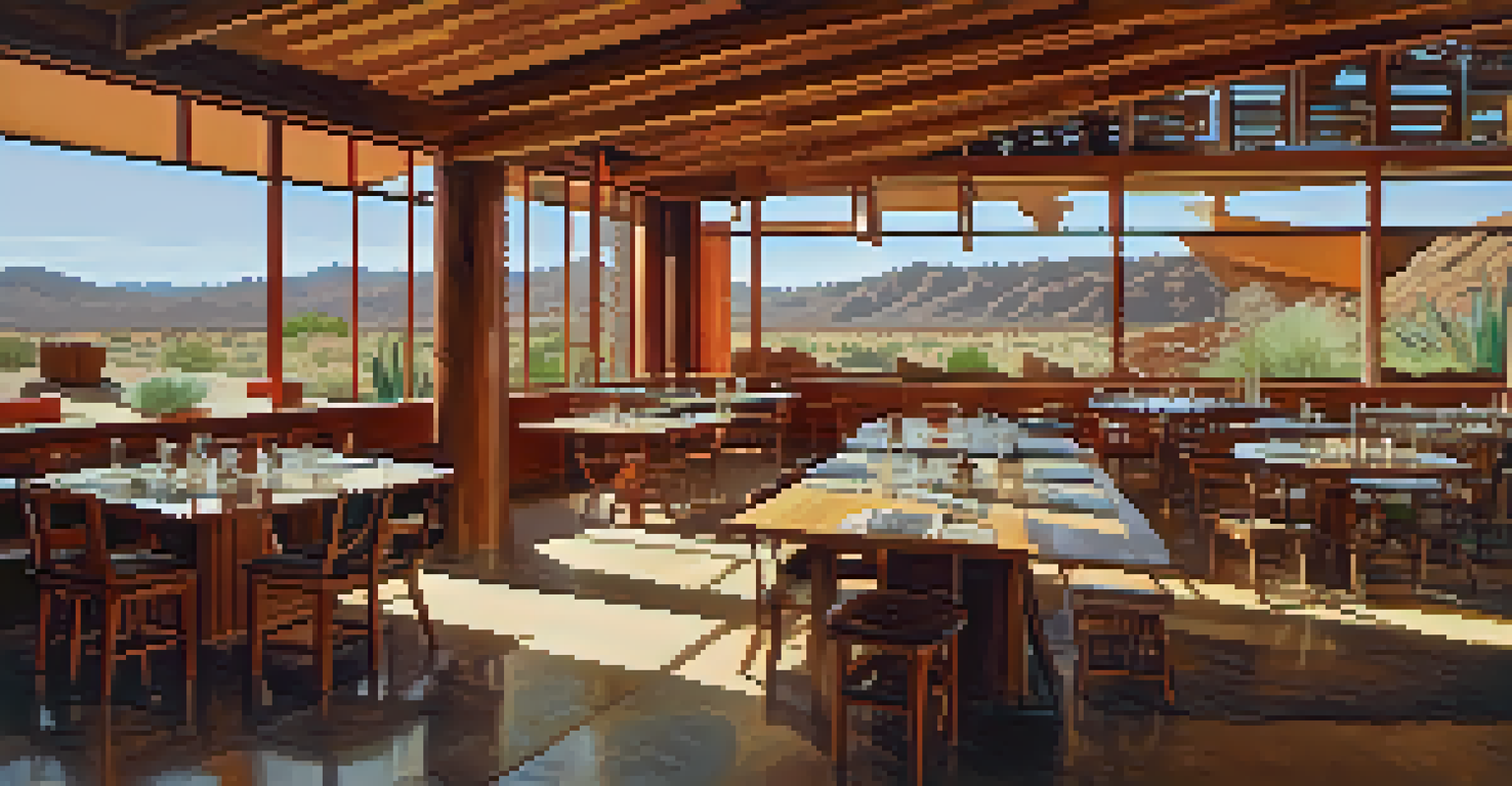Taliesin West: Frank Lloyd Wright's Architectural Masterpiece

The Vision Behind Taliesin West
Taliesin West, located in the stunning Arizona desert, is more than just a structure; it embodies Frank Lloyd Wright's vision of harmony between architecture and nature. Built in 1937, this architectural marvel served as Wright's winter home and school of architecture. His philosophy emphasized organic architecture, which seamlessly blends buildings with their surroundings, making Taliesin West a perfect example of this principle.
The mother art is architecture. Without an architecture of our own, we have no soul of our own civilization.
Wright's approach to design was deeply influenced by his love for nature and the landscape of the Southwest. He sought to create a space that felt like an extension of the desert, using local materials and incorporating the natural elements into the design. This connection to the environment is evident in the way the buildings emerge from the land, rather than imposing upon it.
The vision for Taliesin West was not just about aesthetics; it was also about creating a living space that fostered creativity and collaboration among aspiring architects. Wright believed in the importance of hands-on learning, and Taliesin West became a hub for innovative minds, where students could learn directly from the master himself.
Architectural Features That Inspire
One of the most striking features of Taliesin West is its use of natural materials, like desert stone and wood, which not only reflect the local environment but also create a warm, inviting atmosphere. The buildings are designed with low ceilings and wide, open spaces, promoting a sense of intimacy and comfort. This design choice encourages visitors to feel connected to the site and each other.

The iconic use of cantilevered roofs, a signature of Wright's style, extends the living space outdoors, blurring the lines between inside and outside. This feature not only provides shade from the intense Arizona sun but also creates a seamless transition that invites nature into the daily life of its inhabitants. It’s a perfect example of how functional design can be beautiful.
Taliesin West: Nature and Architecture
Taliesin West exemplifies Frank Lloyd Wright's philosophy of organic architecture, harmonizing buildings with their natural surroundings.
Another remarkable aspect is the integration of art and architecture. Taliesin West is adorned with stunning art pieces and decorative elements, many of which were created by Wright himself. These elements enrich the overall experience, making each corner of the space a visual delight that tells a story of creativity and innovation.
Sustainability: Ahead of Its Time
Wright's focus on sustainability can be seen in the design principles he implemented at Taliesin West, which were groundbreaking for their time. The buildings are oriented to take advantage of natural light and ventilation, reducing the need for artificial heating and cooling. This harmony with the environment exemplifies what we now refer to as green architecture.
Space is the breath of art.
The use of local materials not only minimized transportation costs but also ensured that the buildings blended seamlessly with the desert landscape. Wright's foresight about the importance of sustainability is increasingly relevant today as we face environmental challenges. He understood that architecture should coexist with nature rather than exploit it.
Moreover, Taliesin West continues to serve as a living laboratory for sustainable practices. Today, it operates as a center for education and preservation, teaching future generations about the importance of ecological design. This commitment to sustainability makes Taliesin West not just a historical site but a beacon of innovative thinking.
The Legacy of Taliesin West
Taliesin West is not merely a testament to Frank Lloyd Wright's architectural genius; it is a symbol of his enduring legacy. The site was designated a National Historic Landmark in 1987, ensuring that its significance is recognized and preserved for future generations. Visitors from around the world come to experience Wright's vision and creativity firsthand.
Beyond its architectural brilliance, Taliesin West has influenced countless architects and designers, who draw inspiration from Wright's principles of organic architecture. His methods and philosophies continue to shape modern architectural practices, emphasizing the importance of context and sustainability in design.
Sustainability in Design
Wright's innovative design at Taliesin West showcased sustainable practices, using local materials and natural light to minimize environmental impact.
The impact of Taliesin West extends beyond architecture; it reflects a way of thinking about our relationship with the environment. As we navigate the challenges of urbanization and climate change, Wright's vision reminds us of the importance of designing spaces that honor both humanity and nature.
Visiting Taliesin West: What to Expect
When planning a visit to Taliesin West, prepare for an experience that is both educational and awe-inspiring. Guided tours are available, offering insights into Wright's design principles and the history of the site. As you walk through the beautifully crafted spaces, you'll gain a deeper appreciation for the artistry and thought that went into every detail.
The site also hosts various events and workshops throughout the year, allowing visitors to engage with architecture and design in a hands-on manner. Whether it's a lecture on sustainable practices or a tour focusing on the artistic elements of the buildings, there's something for everyone to explore. These events foster a sense of community and celebrate Wright's legacy.
Don't forget to take some time to enjoy the surrounding desert landscape. The stunning views and natural beauty complement the architectural experience, creating a holistic appreciation for both nature and design. A visit to Taliesin West is not just about architecture; it's a journey into the heart of creativity.
The Role of Taliesin West in Education
Taliesin West serves not only as an architectural wonder but also as an educational institution. The Frank Lloyd Wright Foundation offers programs for students and professionals, focusing on the principles of design, sustainability, and creativity. This commitment to education ensures that Wright's philosophies continue to inspire future generations.
Students from various backgrounds come to Taliesin West to immerse themselves in a unique learning environment. The hands-on approach encourages collaboration and innovation, allowing students to explore their creativity in a supportive community. This experience is invaluable for those aspiring to make their mark in the field of architecture.
Educational Legacy of Taliesin West
Taliesin West continues to serve as an educational hub, inspiring future architects through hands-on learning and a commitment to sustainability.
Furthermore, the foundation's outreach efforts aim to engage the public in discussions about architecture and the environment. By hosting workshops, lectures, and community events, Taliesin West fosters a broader understanding of the importance of design in our lives. This educational aspect makes it a vital part of Wright's legacy.
Preserving Taliesin West for Future Generations
Preservation is a key focus for the Frank Lloyd Wright Foundation, ensuring that Taliesin West remains a vital part of architectural history. Ongoing restoration efforts are undertaken to maintain the integrity of the structures while adapting to modern needs. This balance between preservation and innovation is crucial for keeping Wright's vision alive.
The foundation also emphasizes sustainability in its preservation practices. By using environmentally friendly methods and materials, they demonstrate a commitment to Wright's principles and the environment. This approach not only protects the site but also serves as a model for other historical preservation projects.

Community involvement plays a significant role in the preservation efforts. Local volunteers and enthusiasts often participate in events and initiatives that raise awareness about the importance of Taliesin West. This collective effort ensures that Wright's masterpiece will continue to inspire and educate for years to come.